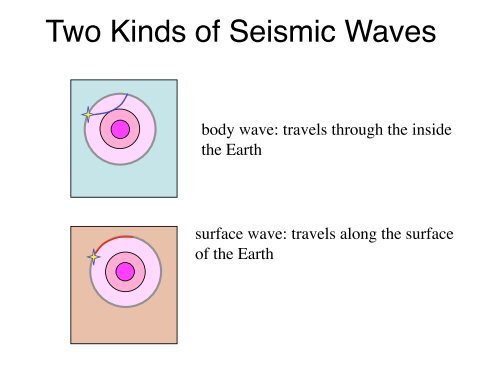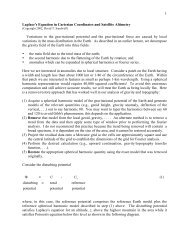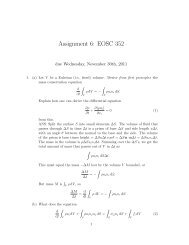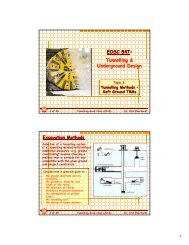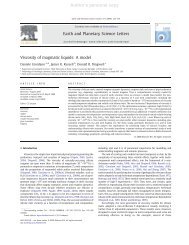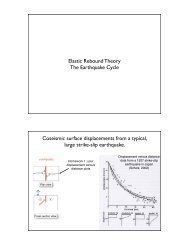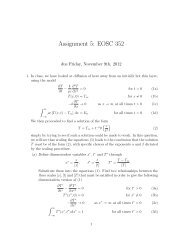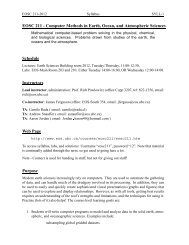Two Kinds of Seismic Waves
Two Kinds of Seismic Waves
Two Kinds of Seismic Waves
Create successful ePaper yourself
Turn your PDF publications into a flip-book with our unique Google optimized e-Paper software.
<strong>Two</strong> <strong>Kinds</strong> <strong>of</strong> <strong>Seismic</strong> <strong>Waves</strong><br />
body wave: travels through the inside<br />
the Earth<br />
surface wave: travels along the surface<br />
<strong>of</strong> the Earth
Wave Type<br />
(and names)<br />
P,<br />
Compressional,<br />
Primary,<br />
Longitudinal<br />
S,<br />
Shear,<br />
Secondary,<br />
Transverse<br />
<strong>Seismic</strong> Body <strong>Waves</strong><br />
Particle Motion<br />
Alternating compressions<br />
(“pushes”) and dilations<br />
(“pulls”) which are directed<br />
in the same direction as the<br />
wave is propagating (along<br />
the raypath)<br />
Alternating transverse<br />
motions (perpendicular to<br />
the direction <strong>of</strong><br />
propagation, and the<br />
raypath); commonly<br />
approximately polarized<br />
such that particle motion is<br />
in vertical or horizontal<br />
planes.<br />
modified from http://web.ics.purdue.edu/~braile/edumod/waves/WaveDemo.htm<br />
Other Characteristics<br />
P motion travels fastest in<br />
materials, so the P-wave is the firstarriving<br />
energy on a seismogram.<br />
Generally smaller and higher<br />
frequency than the S- and Surface<br />
waves. P waves in a liquid or gas<br />
are pressure waves, including sound<br />
waves.<br />
S-waves do not travel through<br />
fluids, so do not exist in Earth’s<br />
outer core (inferred to be primarily<br />
liquid iron) or in air or water or<br />
molten rock (magma). S waves<br />
travel slower than P waves in a<br />
solid and, therefore, arrive after the<br />
P wave.
What type <strong>of</strong> a seismic<br />
body wave is this?<br />
body wave<br />
http://web.ics.purdue.edu/~braile/edumod/waves/WaveDemo.htm
What kind <strong>of</strong> a seismic<br />
body wave is this?<br />
body wave<br />
http://web.ics.purdue.edu/~braile/edumod/waves/WaveDemo.htm
Body <strong>Waves</strong><br />
• P <strong>Waves</strong> (Primary, or Compressional)<br />
! - change in volume <strong>of</strong> the material<br />
! - the wave spreads out in all directions from<br />
! the earthquake in 3D (spherical spreading)<br />
! - fastest seismic wave<br />
• S <strong>Waves</strong> (Shear, or Secondary)<br />
! - change in shape <strong>of</strong> the material<br />
! - spherical spreading<br />
! - slower than P wave
<strong>Seismic</strong> Surface <strong>Waves</strong><br />
L, Love waves Transverse horizontal<br />
motion, perpendicular to<br />
the direction <strong>of</strong><br />
propagation and<br />
generally parallel to the<br />
Earth’s surface<br />
V L<br />
~ 2.0 - 4.5 km/s<br />
in the Earth<br />
depending on<br />
frequency <strong>of</strong> the<br />
propagating wave<br />
Love waves exist because <strong>of</strong> the<br />
Earth’s surface. They are largest at<br />
the surface and decrease in<br />
amplitude with depth. Love waves<br />
are dispersive, that is, the wave<br />
velocity is dependent on frequency,<br />
with low frequencies normally<br />
propagating at higher velocity.<br />
Depth <strong>of</strong> penetration <strong>of</strong> the Love<br />
waves is also dependent on<br />
frequency, with lower frequencies<br />
penetrating to greater depth.<br />
R, Rayleigh<br />
waves, “Ground<br />
roll”<br />
Motion is both in the<br />
direction <strong>of</strong> propagation<br />
and perpendicular (in a<br />
vertical plane).<br />
Appearance and particle<br />
motion are similar to<br />
water waves.<br />
V R<br />
~ 2.0 - 4.5 km/s<br />
in the Earth<br />
depending on<br />
frequency <strong>of</strong> the<br />
propagating wave<br />
Rayleigh waves are also dispersive<br />
and the amplitudes generally<br />
decrease with depth in the Earth.<br />
modified from http://web.ics.purdue.edu/~braile/edumod/waves/WaveDemo.htm
Particles move perpendicular to wave<br />
propagation direction, and horizontally.<br />
What kind <strong>of</strong> a surface wave is this?<br />
surface wave<br />
http://web.ics.purdue.edu/~braile/edumod/waves/WaveDemo.htm
What kind <strong>of</strong> a surface<br />
wave is this?<br />
surface wave<br />
http://web.ics.purdue.edu/~braile/edumod/waves/WaveDemo.htm
Surface waves vs. body waves<br />
• Surface <strong>Waves</strong><br />
– circular spreading from a point (2D), like ripples from a<br />
pebble thrown into a pond<br />
– amplitude decays as 1/(square root <strong>of</strong> distance)<br />
• Body waves<br />
– circular spreading from a point (waves go out in 3D)<br />
– amplitude decays as 1/distance<br />
Surface wave amplitudes decay less<br />
with distance traveled than body wave<br />
amplitudes do.
Animation <strong>of</strong> surface waves
A seismogram<br />
Figure 3.7c<br />
Usually shows ground displacement<br />
vs. time or ground velocity vs. time<br />
(Some show acceleration vs. time)
Frequency: number <strong>of</strong> waves that pass per second<br />
0s<br />
12 per second = 12 Hertz<br />
1s<br />
0s<br />
3 per second = 3 Hertz<br />
1s<br />
meters<br />
Wavelength: length<br />
<strong>of</strong> a wave in meters<br />
(trough to trough or<br />
peak to peak)<br />
http://www.dosits.org/science/whatis/frequency.htm<br />
and math 309 webpage
Frequency and wavelength are related to wave speed<br />
speed = frequency x wavelength<br />
m/s cycles/s m/cycle<br />
Music: Middle C (in air)<br />
- frequency = 261.63 Hz<br />
- wavelength = 1.32 m<br />
- speed <strong>of</strong> sound in air = 345 m/s
How long are earthquake waves?<br />
6 km<br />
speed = frequency x wavelength<br />
Average P-wave crustal velocity: ~6000 m/s or 6 km/s<br />
Frequencies: very broad range<br />
- for 10 Hz waves, wavelength = 600 m<br />
- for 1 Hz waves, about 6 km
How long are earthquake waves?<br />
10 km<br />
speed = frequency x wavelength<br />
Surface wave velocities: slower ~ 2 km/s<br />
Frequencies: lower than body waves<br />
- for 0.2 Hz waves, wavelength = 10 km<br />
Amplitude? Up to Meters at the epicentre, smaller with distance
geophone:<br />
“tweeter”<br />
“wo<strong>of</strong>er”
SEISMOMETERS, SEISMOGRAPHS, SEISMOGRAMS<br />
1. What is a seismometer?<br />
2. What is a seismograph?<br />
3. What is a seismogram
A seismometer is a mechanical device that<br />
measures and amplifies ground motion at a point<br />
on the Earth’s surface or in a borehole
A modern seismograph records ground<br />
motion (from a seismometer) in digital format<br />
onto magnetic or optical disk
A seismogram is a<br />
visual representation<br />
<strong>of</strong> ground motion at a<br />
point in space as a<br />
function <strong>of</strong> time
SEISMOMETERS MEASURE GROUND MOTIONS<br />
> ground motions can be described and measured<br />
in different ways:<br />
1. ground displacement<br />
2. ground velocity<br />
3. ground acceleration<br />
Q1. How are they related?<br />
Q2. Which is most useful?
displacement<br />
u(t)<br />
velocity<br />
du(t)<br />
dt<br />
acceleration<br />
d 2 u(t)<br />
dt 2
damage ~ force ~ acceleration<br />
During large earthquakes, accelerations<br />
can approach or even exceed gravity
SEISMOMETRY EXERCISE<br />
> ground motions provide much important information<br />
on both earthquakes and Earth structure<br />
>NO seismometer provides a perfect representation<br />
<strong>of</strong> ground motion, each one has an (imperfect) response<br />
> we will derive response for a simple damped pendulum<br />
seismometer<br />
> GROUP EXERCISE: I want you to analyse this response<br />
to see how true ground motions are modified by<br />
seismometer
SHORT/LONG PERIOD SEISMOMETERS &<br />
GEOPHONES<br />
> used prior to 1990’s<br />
> work on damped pendulum<br />
theory<br />
> resonant frequency at 1 Hz,<br />
0.1 Hz<br />
> mass incorporates solenoid<br />
which moves in a magnetic field<br />
> Faraday’s law states<br />
ɛ = − dΦ<br />
dt ∼ dv<br />
dt
MODERN BROADBAND SEISMOMETERS<br />
> record motions faithfully<br />
between 100 - 0.001 Hz<br />
> driven by sophisticated<br />
feedback electronic circuits<br />
> motion is measured<br />
through voltage required to<br />
keep masses stationary
STRONG MOTION SEISMOGRAPHS<br />
> made from MEMS &<br />
sensitive to large accelerations<br />
> regular seismometers go<br />
<strong>of</strong>f scale<br />
> used in triggered mode to<br />
study effects <strong>of</strong> large eq’s<br />
> employed by engineers to<br />
aid in design <strong>of</strong> earthquake<br />
resistant infrastructure
SEISMIC NETWORKS<br />
> arrays <strong>of</strong> seismometers deployed for a common<br />
purpose<br />
1. Global <strong>Seismic</strong> Network<br />
2. Regional Networks<br />
3. Portable Arrays<br />
4. EarthScope
GLOBAL SEISMIC NETWORKS<br />
> 150+ stations globally distributed<br />
> high quality stations with detection limit ~M=4<br />
> partly underwritten by military agencies to aid in<br />
nuclear test ban verification treaties
UNDER GROUND VAULT -<br />
KYRGYZSTAN<br />
> note thermal insulation, concrete bunker
SOUTH POLE SITE<br />
> some sites involve seismometers in boreholes to<br />
minimize noise
REGIONAL SEISMOGRAPH NETWORKS<br />
> Japanese Hi-Net has<br />
over 600 short-period,<br />
borehole stations<br />
> since 2000, has led to<br />
many important<br />
discoveries<br />
> 10-20 km spacing
CANADIAN NATIONAL SEISMOGRAPH<br />
NETWORK (B.C.)<br />
> G.S.C. operates ~30<br />
seismographs in SW<br />
B.C.<br />
> note concentration<br />
on V.I. and lower<br />
mainland
PACIFIC NORTHWEST SEISMIC<br />
NETWORK<br />
> UW operates ~100 sp<br />
and ~10-20 BB sites<br />
through Washington and<br />
Oregon<br />
> significant data exchange<br />
between CNSN and<br />
PNSN
STRONG MOTION<br />
SITES - SW BC
PORTABLE ARRAYS<br />
> many countries possess<br />
portable instruments used<br />
for temporary field campaigns<br />
60 o N<br />
65 o N<br />
> Canada: POLARIS (Portable<br />
Observatories for Lithospheric<br />
Analysis and Research<br />
Investigating <strong>Seismic</strong>ity<br />
45 o N<br />
50 o N<br />
55 o N<br />
BATHOLITHS<br />
CANOE<br />
CNSN<br />
POLARIS<br />
OTHERS<br />
> can be used in aftershock or<br />
structural studies<br />
144 o W<br />
136 o W<br />
128 o W<br />
120 o W<br />
112 o W
makeshift<br />
vaults with solar<br />
power<br />
> data archived onto<br />
loggers that record<br />
continuously<br />
> typical deployment<br />
1-2 years<br />
PORTABLE ARRAY VAULTS
new generation <strong>of</strong> portable experiment; cover whole<br />
USA at 70 km spacing<br />
> each station active for 18 months, deployed roll-along<br />
array over 15 years
SEISMOGRAMS<br />
> incredibly rich and varied in appearance depending on<br />
source, frequency content, distance etc.


